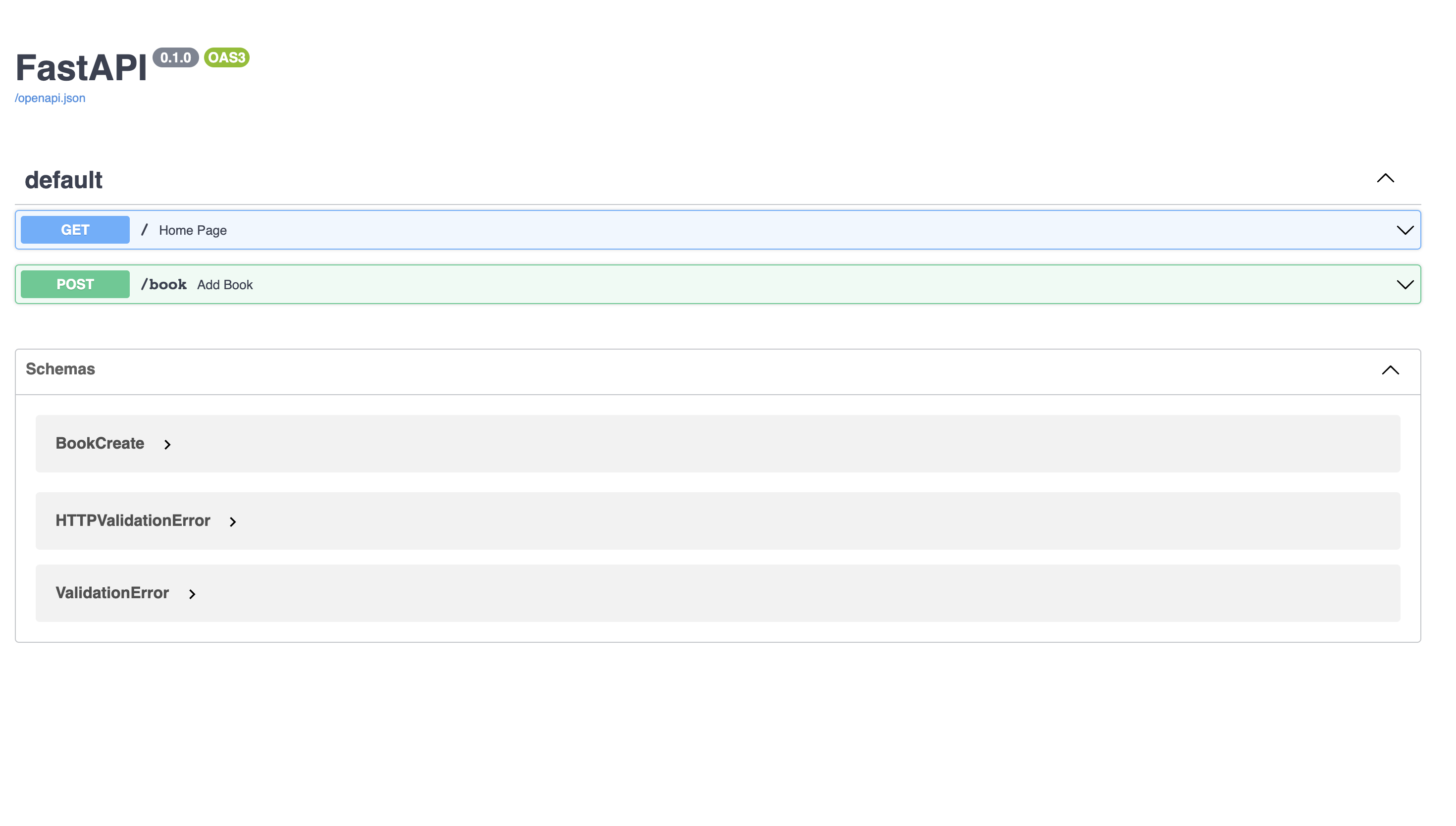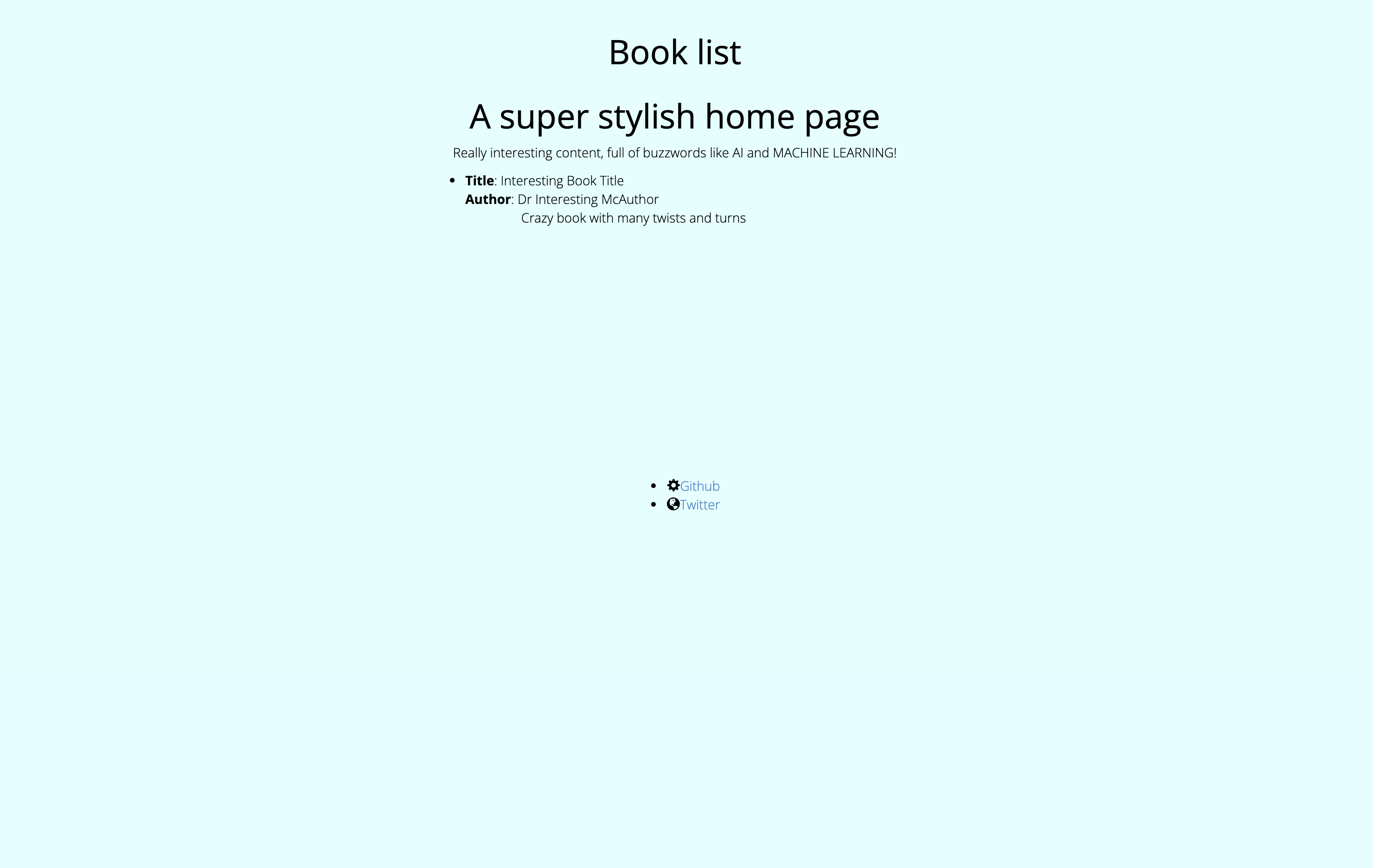fastbooks - FastAPI, sqlmodel, alembic and Jinja
We will be building a fastapi app using sqlmodel to handle a connection to the database, alembic for migrations, and Jinja2 templates for the front end. Let's get straight into it!
To see the full code, see this git repo.
Package requirements
We will start by installing all the packages we will need into a virtual environment.
python3 -m venv fastenv
source fastenv/bin/activate
pip install fastapi sqlmodel uvicorn Jinja2 aiofiles
Those packages are enough to get off the ground for local development. We will be using an sqlite database for local development, but when we deploy to Heroku we'll use Postgres so let's install some additional things we need for later.
pip install psycopg2 alembic gunicorn
We also installed alembic for database migrations, and gunicorn to use as a production server. The psycopg2 package allows sqlmodel (which uses SQLAlchemy underneath) to talk to Postgres databases.
Those are all the packages we are going to need, so let's save them to a requirements.txt file before we forget.
pip freeze > requirements.txt
Fastapi app
Start by making the files main.py and __init__.py inside a directory called app, so that the file structure looks like this:
.
├── app
│ ├── __init__.py
│ ├── main.py
├── bookenv
│ ├── bin
│ ├── include
│ ├── lib
│ └── pyvenv.cfg
└── requirements.txt
# app/main.py
from fastapi import FastAPI
import uvicorn
app = FastAPI()
@app.get("/")
def home_page():
return {"message": "Hello!"}
if __name__=="__main__":
uvicorn.run('app.main:app', reload=True)
Running this with python -m app.main should start up a server on port 8000 on your localhost, so going to 127.0.0.1:8000 should show you the message
{"message": "Hello!"}
Making it look nice
Before setting up our database and models, let's make the first page look nice using Jinja templates.
from fastapi import FastAPI
import uvicorn
from starlette.staticfiles import StaticFiles
from starlette.templating import Jinja2Templates
from starlette.requests import Request
templates = Jinja2Templates('app/templates')
app = FastAPI()
def configure():
app.mount('/static', StaticFiles(directory='app/static'), name='static')
@app.get("/")
def home_page(request: Request):
return templates.TemplateResponse('index.html', {'request': request})
if __name__=="__main__":
configure()
uvicorn.run('app.main:app', reload=True)
else:
configure()
After importing the required packages, we set up the templates with Jinja2Templates('app/templates') and also mount the static files so that fastapi can find them with app.mount('/static', StaticFiles(directory='app/static', name='static'), so we need to make 2 directories:
mkdir app/static
mkdir app/templates
Inside templates, we'll create the following index.html file,
<!DOCTYPE html>
<html lang="en-us">
<head>
<meta charset="utf-8">
<meta http-equiv="X-UA-Compatible" content="IE=edge">
<meta name="viewport" content="width=device-width, initial-scale=1.0">
<meta name="description" content="A website showcasing fastapi and sqlmodel">
<meta name="author" content="idjotherwise">
<title>Fastsqlmodel showcase</title>
<link href="//oss.maxcdn.com/libs/twitter-bootstrap/3.0.3/css/bootstrap.min.css" rel="stylesheet">
</head>
<body>
<h1>
A super stylish home page
</h1>
<p>
Really interesting content, full of buzzwords like AI and MACHINE LEARNING!
</p>
</body>
</html>
Now we can run the app to check that things are working so far,
python -m main.app
If everything has gone well, after opening up localhost:8000, you should be greeted with

We'll refactor the jinja templates later, but that will do for now.
Next we'll set up some database stuff, including some models to hold our data.
Database: sqlmodel
In a new file called database.py, we'll set up the database engine and session handler.
# app/database.py
from sqlmodel import SQLModel, create_engine, Session
from .settings import settings
connect_args = {"check_same_thread": False}
engine = create_engine(settings.database_url), connect_args=connect_args)
def create_db_and_tables():
SQLModel.metadata.create_all(engine)
def get_session():
with Session(engine) as session:
yield session
and in the file settings.py we'll define the DATABASE_URL,
# app/settings.py
from pydantic import BaseSettings
class Settings(BaseSettings):
database_url: str = 'sqlite:///database.db'
This may seem uncessarily complex, but it will make things easier later. When your class Settings inherits from BaseSettings, it will first try to get the attributes from your environment but if it doesn't find anything it will set it to the default you've given. So in our case (assuming you haven't set DATABASE_URL to anything else in your terminal) it will simply be the sqlite database url. On Heroku, environment variables like DATABASE_URL are set automatically (if you have installed a Postgres add-on).
Before we actually create the database, we should create a model that will go into the database. In a new file models.py,
# app/models.py
from sqlmodel import SQLModel, Field
from typing import Optional
class BookBase(SQLModel):
title: str
author: Optional[str]
class Book(BookBase, table=True):
id: Optional[int] = Field(default=None, primary_key=True)
In sqlmodel, models can be treated as both Pydantic models and SQLAlchemy models. That's all it takes to create the table called Book in the database. Now let's actually create the table, we add some code to main.py
# app/main.py
from fastapi import FastAPI, Depends
import uvicorn
from starlette.staticfiles import StaticFiles
from starlette.templating import Jinja2Templates
from starlette.requests import Request
from sqlmodel import Session, select
from .database import create_db_and_tables, get_session
from .models import Book
templates = Jinja2Templates('app/templates')
app = FastAPI()
def configure():
create_db_and_tables()
app.mount('/static', StaticFiles(directory='app/static'), name='static')
@app.get("/")
def home_page(*, session: Session = Depends(get_session), request: Request):
books = session.exec(select(Book)).all()
return templates.TemplateResponse('index.html', {'request': request})
if __name__=="__main__":
configure()
uvicorn.run('app.main:app', reload=True)
else:
configure()
Finally add the following bit of code to the index.html file (see the Jinja documentation for more information),
<!DOCTYPE html>
<html lang="en-us">
<head>
<meta charset="utf-8">
<meta http-equiv="X-UA-Compatible" content="IE=edge">
<meta name="viewport" content="width=device-width, initial-scale=1.0">
<meta name="description" content="A website showcasing fastapi and sqlmodel">
<meta name="author" content="idjotherwise">
<title>Fastsqlmodel showcase</title>
<link href="//oss.maxcdn.com/libs/twitter-bootstrap/3.0.3/css/bootstrap.min.css" rel="stylesheet">
</head>
<body style="text-align: center">
<h1>
A super stylish home page
</h1>
<p>
Really interesting content, full of buzzwords like AI and MACHINE LEARNING!
</p>
{% if books %}
<ul>
{% for book in books %}
<li key="{{book.id}}">Title: {{book.title}}, Author: {{book.author}}</li>
{% endfor %}
</ul>
{% endif %}
</body>
</html>
At this point, if you navigate localhost:8000, you won't see anything has changed - that's because our database is empty. But if the database did have books in it, then in the get request the books = session.exec(select(Book)).all() would contain a list of book items, and so our Jinja template index.html would get passed a non-empty list.
There are many ways to add data into our database. You could use SQLite Browser to open the database.db file, PyCharm's own database reader, or any other database browser. Instead, we will add a POST route so that we can add in data from the browser.
Add the following code the main.py, just below the @app.get('/') route.
@app.post("/book")
def add_book(*, session: Session = Depends(get_session), request: Request, book: BookCreate) -> BookRead:
db_book = Book.from_orm(book)
session.add(db_book)
session.commit()
session.refresh(db_book)
return db_book
We've added in two new models here, BookCreate and BookRead. Add them to the models.py file.
# app/models.py
from sqlmodel import SQLModel, Field
from typing import Optional
class BookBase(SQLModel):
title: str
author: Optional[str]
class Book(BookBase, table=True):
id: Optional[int] = Field(default=None, primary_key=True)
class BookCreate(BookBase):
pass
class BookRead(BookBase):
id: int
Now, navigate to localhost:8000/docs in your browser, and you should see the POST method right there:

Click on the post request and add a few books in. These will now be saved into the database.
Thanks to the way we wrote the index.html file, if you navigate again to the home page (localost:8000), you should see the books that you just added.
Since we didn't implement @app.delete or @app.patch methods, we can't delete or update the entries. To start afresh, you can just delete the database.db file and re-add the books.
Adding a description column with Alembic
Now let's say that we want to add a description field to the book items. We could just delete the database.db file, make the changes to the Book model, and restart the app. However, if we were in the situation where the database had a bunch of entries that you don't want to lose, then using migrations is the way to go. We'll be using alembic, see the documentation for more information. We need to do a few changes to the setup since we are using sqlmodel and not sqlalchemy. TestDriven.io has a nice tutorial showing how to do this, so we'll follow that here (although we won't be using the async version)
Start by going to the terminal, from root directory of the project, run
alembic init alembic
This will make a directory called alembic with some files that we need to modify. The project structure should now look like this
.
|-- alembic
| |-- README
| |-- env.py
| |-- script.py.mako
| `-- versions
|-- alembic.ini
|-- app
| |-- __init__.py
| |-- database.py
| |-- main.py
| |-- models.py
| |-- settings.py
| `-- static/
| `-- templates
| `-- index.html
|-- database.db
`-- requirements.txt
In the script.py.mako file, we need to import sqlmodel:
# alembic/script.py.mako
# code above ommited
from alembic import op
import sqlalchemy as sa
import sqlmodel
${imports if imports else ""}
# code below ommited
and finally in the alembic/env.py add the following imports,
from logging.config import fileConfig
from sqlalchemy import engine_from_config
from sqlalchemy import pool
from alembic import context
from sqlmodel import SQLModel
from app.settings import settings
from app.models import Book
# this is the Alembic Config object, which provides
# access to the values within the .ini file in use.
config = context.config
config.set_main_option("sqlalchemy.url", settings.database_url)
# Interpret the config file for Python logging.
# This line sets up loggers basically.
fileConfig(config.config_file_name)
# add your model's MetaData object here
# for 'autogenerate' support
# target_metadata = mymodel.Base.metadata
target_metadata = SQLModel.metadata
# ---- code below omitted ---
All we've done here is import the SQLModel from sqlmodel, which holds all the metadata about our database (after also importing our Book model), then we've grabbed the database_url from the settings file.
Now delete the database.db file, and then generate the first alembic migration with alembic revision -autogenerate -m "Add book table" to verify that everything sets up properly. If successful, you will find a new file in the alembic/revisions directory which looks something like this (the revision ID might be different):
"""Add book table
Revision ID: 7071875a0907
Revises:
Create Date: 2021-09-12 22:16:26.595677
"""
from alembic import op
import sqlalchemy as sa
import sqlmodel
# revision identifiers, used by Alembic.
revision = '7071875a0907'
down_revision = None
branch_labels = None
depends_on = None
def upgrade():
# ### commands auto generated by Alembic - please adjust! ###
op.create_table('book',
sa.Column('title', sqlmodel.sql.sqltypes.AutoString(), nullable=False),
sa.Column('author', sqlmodel.sql.sqltypes.AutoString(), nullable=True),
sa.Column('id', sa.Integer(), nullable=True),
sa.PrimaryKeyConstraint('id')
)
op.create_index(op.f('ix_book_author'), 'book', ['author'], unique=False)
op.create_index(op.f('ix_book_id'), 'book', ['id'], unique=False)
op.create_index(op.f('ix_book_title'), 'book', ['title'], unique=False)
# ### end Alembic commands ###
def downgrade():
# ### commands auto generated by Alembic - please adjust! ###
op.drop_index(op.f('ix_book_title'), table_name='book')
op.drop_index(op.f('ix_book_id'), table_name='book')
op.drop_index(op.f('ix_book_author'), table_name='book')
op.drop_table('book')
# ### end Alembic commands ###
Apply the migration (which just creates the table in the database) with alembic upgrade head.
Now to add a new column to the book table in the database, add the following to the Book model in app/models.py,
...
class BookBase(SQLModel):
title: str
author: Optional[str]
description: Optional[str]
...
and then generate another migration file with
alembic revision --autogenerate -m "Add description column"
This gives us the following migration file,
"""Add description column
Revision ID: 0b26b04f3af4
Revises: 7071875a0907
Create Date: 2021-09-12 22:55:29.481379
"""
from alembic import op
import sqlalchemy as sa
import sqlmodel
# revision identifiers, used by Alembic.
revision = '0b26b04f3af4'
down_revision = '7071875a0907'
branch_labels = None
depends_on = None
def upgrade():
# ### commands auto generated by Alembic - please adjust! ###
op.add_column('book', sa.Column('description', sqlmodel.sql.sqltypes.AutoString(), nullable=True))
op.create_index(op.f('ix_book_description'), 'book', ['description'], unique=False)
# ### end Alembic commands ###
def downgrade():
# ### commands auto generated by Alembic - please adjust! ###
op.drop_index(op.f('ix_book_description'), table_name='book')
op.drop_column('book', 'description')
# ### end Alembic commands ###
Apply the migration with alembic upgrade head.
Update Jinja template
Now we are going to modify the jinja template in index.html to use the new description column. While we're at it, lets add some more styling to the page with a header and a footer. For this, we'll create a new file templates/layout.html. In there we will put all the things from index.html that should go on every page (if there were more pages).
<!DOCTYPE html>
<html lang="en-us">
<head>
<meta charset="utf-8">
<meta http-equiv="X-UA-Compatible" content="IE=edge">
<meta name="viewport" content="width=device-width, initial-scale=1.0">
<meta name="description" content="A website showcasing fastapi and sqlmodel">
<meta name="author" content="idjotherwise">
<title>Fastsqlmodel showcase</title>
<link href="//oss.maxcdn.com/libs/twitter-bootstrap/3.0.3/css/bootstrap.min.css" rel="stylesheet">
<link href="/static/css/styling.css" rel="stylesheet">
</head>
<body >
<div class="content-wrapper">
<div class="container">
<div class="row">
<h1>
Book list
</h1>
</div>
</div>
<div class="row">
<div class="col-md-10">
<div>
{% block content %}
<div class="content">
THIS PAGE HAS NO CONTENT
</div>
{% endblock %}
</div>
</div>
</div>
<div class="footer">
<div class="footer links">
<ul>
<li><i class="glyphicon glyphicon-cog icon-muted"></i><a
href="https://github.com/idjotherwise"
target="_blank">Github</a>
</li>
<li><i class="glyphicon glyphicon-globe icon-muted"></i><a href="https://twitter.com/johnstonifan"
target="_blank">Twitter</a>
</li>
</ul>
</div>
</div>
</div>
</body>
</html>
Now our app/templates/index.html will extend the app/templates/layout.html file:
{% extends "layout.html" %}
{% block content %}
<h1>
A super stylish home page
</h1>
<p>
Really interesting content, full of buzzwords like AI and MACHINE LEARNING!
</p>
{% if books %}
<ul style="text-align: left">
{% for book in books %}
<li key="{{book.id}}"><b>Title</b>: {{book.title}}<br/>
<b>Author</b>: {{book.author}}</li>
<p style="padding-left: 6rem;">{{book.description}}</p>
{% endfor %}
</ul>
{% endif %}
{% endblock %}
Finally, we'll add some simple styling in the file app/static/css/styling.css. You can also just put in your own style file here if you like.
@import url(//fonts.googleapis.com/css?family=Open+Sans:300,400,600,700);
body {
font-family: "Open Sans", "Helvetica Neue", Helvetica, Arial, sans-serif;
font-weight: 300;
color: black;
background: lightcyan;
width: 100%;
}
h1,
h2,
h3,
h4,
h5,
h6 {
font-family: "Open Sans", "Helvetica Neue", Helvetica, Arial, sans-serif;
font-weight: 400;
}
p {
font-weight: 300;
}
.content-wrapper {
display: flex;
flex-direction: row;
flex-wrap: wrap;
margin: 2rem auto 0 auto;
height: 85vh;
text-align: center;
width: 56rem;
justify-content: center;
}
Opening up the browser again to localhost:8000 should greet you with something like

As you can see, I used the locahost:8000/docs page to add a very interesting sounding book to the database and it showed up on the home page. Try adding a bunch more books to see the page filling up. Also go ahead and modify the styling to make it look actually stylish!
Conclusion
We've done quite a bit here! In another post, we'll clean things
up a bit by adding tests with pytest and then deploy to Heroku. We'll also refactor some of the endpoints (and add some more) to use
the powerful response model stuff from fastapi/sqlmodel.
Thanks for reading!
